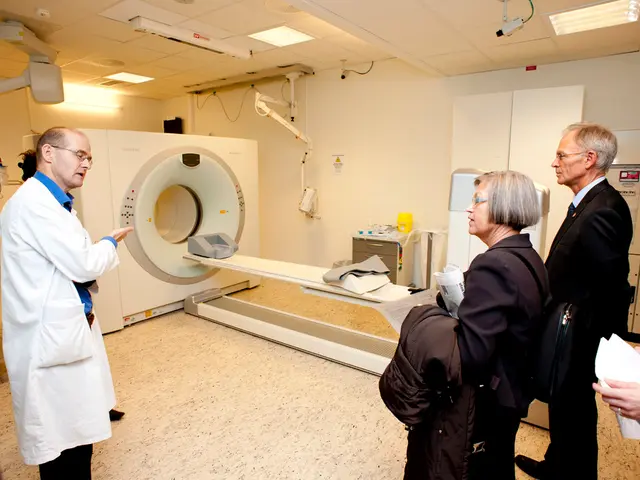MRI Scans for Cervical Cancer: Details, Outcomes, and Additional Tests Requirements
An MRI (Magnetic Resonance Imaging) scan plays a crucial role in the diagnosis, staging, treatment planning, and monitoring of cervical cancer. These non-invasive tests offer detailed anatomical imaging, helping assess tumor size, local invasion, and involvement of adjacent tissues.
During an MRI scan, a person lies down on a narrow table and may be provided with pillows and straps for comfort. The table is then slid into a cylindrical machine, with the pelvic area in the center of the cylinder. The MRI machine may produce loud sounds, such as whirring, banging, and clicking. Despite being painless, some people may find it uncomfortable or frightening to be enclosed in the scanning machine; relaxation techniques or sedatives may be used to help.
In diagnosing and staging cervical cancer, MRI is used to determine how far the cancer has spread locally. Specifically, it helps assess the depth of stromal invasion and parametrial involvement (PMI), which are key factors in staging. Accurate MRI staging assists clinicians in deciding the cancer stage, which directly influences treatment choice.
MRI provides high-resolution soft tissue contrast that outperforms CT scans for assessing tumor extension to surrounding tissues, allowing better differentiation between tumor and normal cervical anatomy. Advanced techniques such as multiparametric MRI and MRI-based radiomics enable quantitative analysis of imaging features, improving predictive accuracy for PMI and tumor behavior, thereby aiding treatment optimization.
MRI is also essential in treatment planning, helping to map the exact tumor volume and its relation to surrounding organs. This information guides decisions such as the extent of surgery or radiation therapy fields. During and after treatment, MRI is used for monitoring therapeutic response and detecting residual or recurrent disease, enabling timely adjustments in therapy.
Compared to other imaging, MRI is radiation-free and can be combined with machine learning techniques to enhance diagnostic and prognostic performance.
Before the MRI, a person should remove metal objects on their person, such as jewelry, piercings, and hair accessories. Some MRIs require the use of contrast material, called gadolinium, which may be swallowed or injected intravenously.
If cervical cancer is discovered, further tests may involve proctoscopy, cystoscopy, CT scans, X-rays, and PET scans. Permanently implanted materials such as pacemakers, implanted defibrillators, cochlear implants, or brain aneurysm clips should not be brought into the MRI scanning area unless cleared by an MRI technician or radiologist.
After the MRI scan, a radiologist will examine the images and compile the results for the ordering doctor. If necessary, the person will have to wait 1 or 2 weeks to receive their MRI results and discuss them with a doctor.
MRI scans can help doctors plan surgery or radiation therapy, making them an indispensable tool for comprehensive cervical cancer management, from initial diagnosis and precise staging to personalized treatment planning and ongoing monitoring.
- In some cases, beyond cervical cancer, MRI scans can also be useful for diagnosing and assessing other medical conditions, such as breast cancer.
- Interestingly, MRI scans are not only radiation-free but can also be combined with science and technology, like machine learning, to improve diagnostic and prognostic performance.
- Despite MRI's crucial role in the detection and monitoring of cervical cancer, it's important to note that other tests like proctoscopy, cystoscopy, CT scans, X-rays, and PET scans may also be necessary for a comprehensive evaluation of cancer.
- The diagnostic superiority of MRI over other imaging techniques like CT scans lies in its high-resolution soft tissue contrast, which allows better differentiation between tumors and normal anatomy.
- A follow-up appointment may be scheduled for the person to discuss their MRI results with a doctor, usually within 1 or 2 weeks after the scan.
- The essence of various therapies and treatments in cancer care, including cervical cancer, relies heavily on the insights and recommendations provided by MRI scans, especially in planning and adjusting surgeries or radiation therapy.



![Guide for Crafting Therapy Recordings [Template Included + Sample Scenarios]](/en/content/images/size/w640/format/webp/20250818061545_therapy-note-templates-examples.jpeg)
